Rapid Detection of the Activity of Lacticaseibacillus Casei Zhang by Flow Cytometry
Abstract
:1. Introduction
2. Materials and Methods
2.1. Bacterial Strain and Culture Conditions
2.2. Strain Activation
2.3. Preparation of Lb. casei Zhang Culture
2.4. Freeze-Drying of Lb. casei Zhang
2.5. Optimization of FCM Conditions
2.5.1. Optimization of Dye Addition and Dyeing Time
2.5.2. Optimization of Sample Loading Speed and Time Combination
2.5.3. Optimization of Threshold
2.5.4. Gain Optimization
2.6. Detection of the Viability/Activity of Freeze-Dried Lb. casei Zhang
2.7. Statistics
3. Results and Discussion
3.1. Determination of Lb. casei Zhang Culture Purity by Optical Microscopy
3.2. Detection of Different Cell Densities of Lb. casei Zhang by FCM and Plate Count
3.3. Determination of the Dye Concentration and Dyeing Time
3.4. Optimal Combination of Sample Loading Speed and Time
3.5. Threshold Calibration
3.6. Gain Calibration
3.7. Detection of Lb. casei Zhang Bacterial Powder
4. Conclusions
Author Contributions
Funding
Data Availability Statement
Conflicts of Interest
References
- Son, J.; Jeong, K.J. Recent advances in synthetic biology for the engineering of lactic acid bacteria. Biotechnol. Bioprocess Eng. 2020, 25, 962–973. [Google Scholar] [CrossRef]
- Mathur, H.; Beresford, T.P.; Cotter, P.D. Health benefits of Lactic acid bacteria (LAB) fermentates. Nutrients 2020, 12, 1679. [Google Scholar] [CrossRef]
- Hor, Y.-Y.; Lew, L.-C.; Lau, A.S.-Y.; Ong, J.-S.; Chuah, L.-O.; Lee, Y.-Y.; Choi, S.-B.; Rashid, F.; Wahid, N.; Sun, Z.; et al. Probiotic Lactobacillus casei Zhang alleviates respiratory, gastrointestinal & RBC abnormality via immuno-modulatory, anti-inflammatory & anti-oxidative actions. J. Funct. Foods 2018, 44, 235–245. [Google Scholar]
- Bai, M.; Huang, T.; Guo, S.; Wang, Y.; Wang, J.; Kwok, L.-Y.; Dan, T.; Zhang, H.; Bilige, M. Probiotic Lactobacillus casei Zhang improved the properties of stirred yogurt. Food Biosci. 2020, 37, 100718. [Google Scholar] [CrossRef]
- Zheng, J.; Wittouck, S.; Salvetti, E.; Franz, C.M.; Harris, H.M.; Mattarelli, P.; O’toole, P.W.; Pot, B.; Vandamme, P.; Walter, J.; et al. A taxonomic note on the genus Lactobacillus: Description of 23 novel genera, emended description of the genus Lactobacillus Beijerinck 1901, and union of Lactobacillaceae and Leuconostocaceae. Int. J. Syst. Evol. Microbiol. 2020, 70, 2782–2858. [Google Scholar] [CrossRef]
- He, Q.; Hou, Q.; Wang, Y.; Shen, L.; Sun, Z.; Zhang, H.; Liong, M.-T.; Kwok, L.-Y. Long-term administration of Lactobacillus casei Zhang stabilized gut microbiota of adults and reduced gut microbiota age index of older adults. J. Funct. Foods 2019, 64, 103682. [Google Scholar] [CrossRef]
- Davis, C. Enumeration of probiotic strains: Review of culture-dependent and alternative techniques to quantify viable bacteria. J. Microbiol. Methods 2014, 103, 9–17. [Google Scholar] [CrossRef] [Green Version]
- Chiron, C.; Tompkins, T.A.; Burguière, P. Flow cytometry: A versatile technology for specific quantification and viability assessment of micro-organisms in multistrain probiotic products. J. Appl. Microbiol. 2017, 124, 572–584. [Google Scholar] [CrossRef] [Green Version]
- O’Donnell, S.T.; Ross, R.P.; Stanton, C. The progress of multi-omics technologies: Determining function in lactic acid bacteria using a systems level approach. Front. Microbiol. 2020, 10, 3084. [Google Scholar] [CrossRef] [Green Version]
- Cai, Y.W.; Liu, J.Y.; Li, G.Y.; Wong, P.K.; An, T.C. Formation mechanisms of viable but nonculturable bacteria through induction by lightbased disinfection and their antibiotic resistance gene transfer risk: A review. Crit. Rev. Environ. Sci. Technol. 2021, 51, 3651–3688. [Google Scholar]
- Foddai, A.C.G.; Grant, I.R. Methods for detection of viable foodborne pathogens: Current state-of-art and future prospects. Appl. Microbiol. Biotechnol. 2020, 104, 4281–4288. [Google Scholar] [CrossRef] [PubMed] [Green Version]
- Liu, J.Y.; Li, L.; Li, B.; Brian, M.; Deng, Y.; Xu, Z.B. Study on spoilage capability and VBNC state formation and recovery of Lactobacillus plantarum. Microb. Pathog. 2017, 110, 257–261. [Google Scholar] [CrossRef] [PubMed]
- Foglia, C.; Allesina, S.; Amoruso, A.; Prisco, A.D.; Pane, M. New insights in enumeration methodologies of probiotic cells in finished products. J. Microbiol. Methods 2020, 175, 105993. [Google Scholar] [CrossRef]
- Nocker, A.; Cheung, C.; Camper, A. Comparison of propidium monoazide with ethidium monoazide for differentiation of live vs. dead bacteria by selective removal of DNA Dead Cells. J. Microbiol. Methods 2006, 67, 310–320. [Google Scholar] [CrossRef] [PubMed]
- Buysschaert, B.; Byloos, B.; Leys, N.; Houdt, V.R.; Boon, N. Reevaluating multicolor flow cytometry to assess microbial viability. Appl. Microbiol. Biotechnol. 2016, 100, 9037–9051. [Google Scholar] [CrossRef] [PubMed]
- Wilkinson, M.G. Flow cytometry as a potential method of measuring bacterial viability in probiotic products: A review. Trends Food Sci. Technol. 2018, 78, 1–10. [Google Scholar] [CrossRef]
- Hoefel, D.; Grooby, W.L.; Monis, P.T.; Andrews, S.; Saint, C.P. A comparative study of carboxyfluorescein diacetate and carboxyfluorescein diacetate succinimidyl ester as indicators of bacterial activity. J. Microbiol. Meth. 2003, 52, 379–388. [Google Scholar] [CrossRef]
- Robinson, J.P.; Darzynkiewicz, Z.; Dean, P.N.; Orfao, A.; Ribinovitch, P.S.; Stewart, C.C.; Tanke, H.J.; Wheeless, L.L.; Dressler, L.G. Current Protocols in Cytometry; Wiley: New York, NY, USA, 1997; Volume 122, p. 660. [Google Scholar]
- Pane, M.; Allesina, S.; Amoruso, A.; Nicola, S.; Deidda, F.; Mogna, L. Flow Cytometry Evolution of microbiological methods for Probiotics Enumeration. J. Clin. Gastroenterol. 2018, 52, 41–45. [Google Scholar] [CrossRef]
- Suo, Y.Z.; Gu, Z.Q.; Wei, X.B. Advances of in vivo flow cytometry on cancer studies. Cytom. Part A 2018, 97, 15–23. [Google Scholar] [CrossRef]
- Mejuto, P.; Luengo, M.; Díaz-Gigante, J. Automated flow cytometry: An alternative to urine culture in a routine clinical microbiology laboratory? Int. J. Microbiol. 2017, 1, 8532736. [Google Scholar] [CrossRef] [Green Version]
- Safford, H.R.; Bischel, H.N. Flow cytometry applications in water treatment, distribution, and reuse: A review. Water Res. 2019, 151, 110–133. [Google Scholar] [CrossRef] [PubMed]
- Kalina, T.; Abraham, R.S.; Rizzi, M.; Burg, M.V.D. Editorial: Application of cytometry in primary immunodeficiencies. Front. Immunol. 2020, 11, 463. [Google Scholar] [CrossRef] [Green Version]
- Léonard, L.; Chibane, L.B.; Bouhedda, B.O.; Degraeve, P.; Oulahal, N. Recent advances on multi-parameterflow cytometry to characterize antimicrobial treatments. Front. Microbiol. 2016, 7, 1225. [Google Scholar] [CrossRef] [PubMed] [Green Version]
- Cao, R.H.; Wan, Q.Q.; Tan, L.L.; Xu, X.Q.; Wu, G.H.; Wang, J.Y. Evaluation of the vital viability and their application in fungal spores’disinfection with flow cytometry. Chemosphere 2021, 269, 128700. [Google Scholar] [CrossRef] [PubMed]
- Majeed, M.; Majeed, S.; Nagabhushanam, K.; Punnapuzha, A.; Philip, S.; Mundkur, L. Rapid assessment of viable but non-culturable Bacillus coagulans MTCC 5856 in commercial formulations using flowcytometry. PLoS ONE 2018, 13, 0192836. [Google Scholar] [CrossRef] [Green Version]
- GB/T 39730-2020. General Requirements for Cell Counting Flow Cytometry. State Administration of Market Supervision and the National Standardization Administration: Beijing, China, 2020.
- Barr, D.A.; Omollo, C.; Mason, M.; Koch, A.; Wilkinson, R.J.; Lalloo, D.G.; Meintjes, G.; Mizrahi, V.; Warner, D.F.; Davies, G. Flow cytometry method for absolute counting and single-cell phenotyping of mycobacteria. Sci. Rep. 2021, 11, 18661. [Google Scholar] [CrossRef]
- Cassoli, L.D.; Lima, W.J.F.; Esguerra, J.C.; Silva, J.D.; Machado, P.F.; Mourão, G.B. Do different standard plate counting (IDF/ISSO or AOAC) methods interfere in the conversion of individual bacteria counts to colony forming units in raw milk. J. Appl. Microbiol. 2016, 121, 1052–1058. [Google Scholar] [CrossRef]
- He, S.; Hong, X.; Huang, T.; Zhang, W.; Zhou, Y.; Wu, L.; Yan, X. Rapid quantification of live/dead lactic acid bacteria in probiotic products using high-sensitivity flow cytometry. Methods Appl. Fluores 2017, 5, 024002. [Google Scholar] [CrossRef]
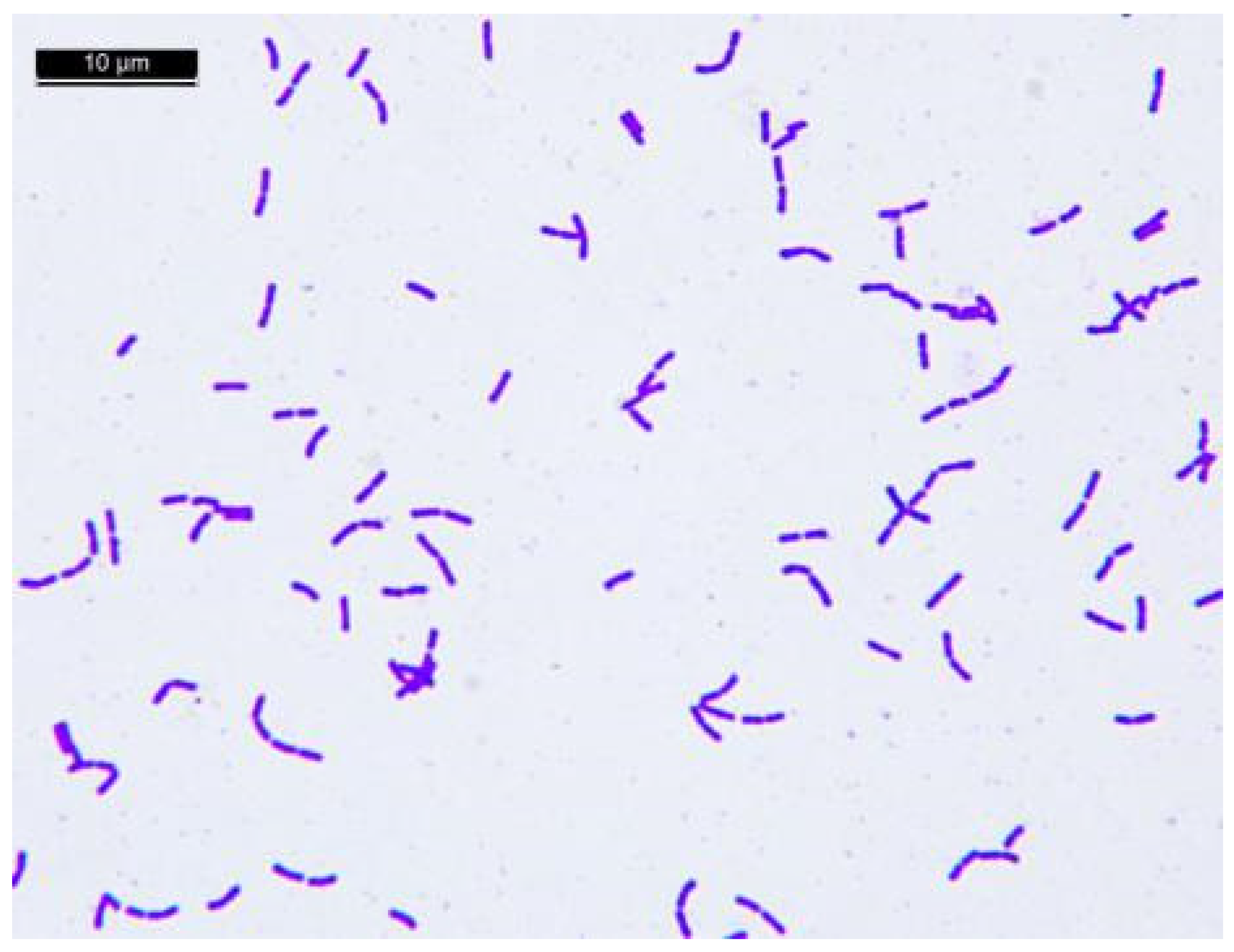



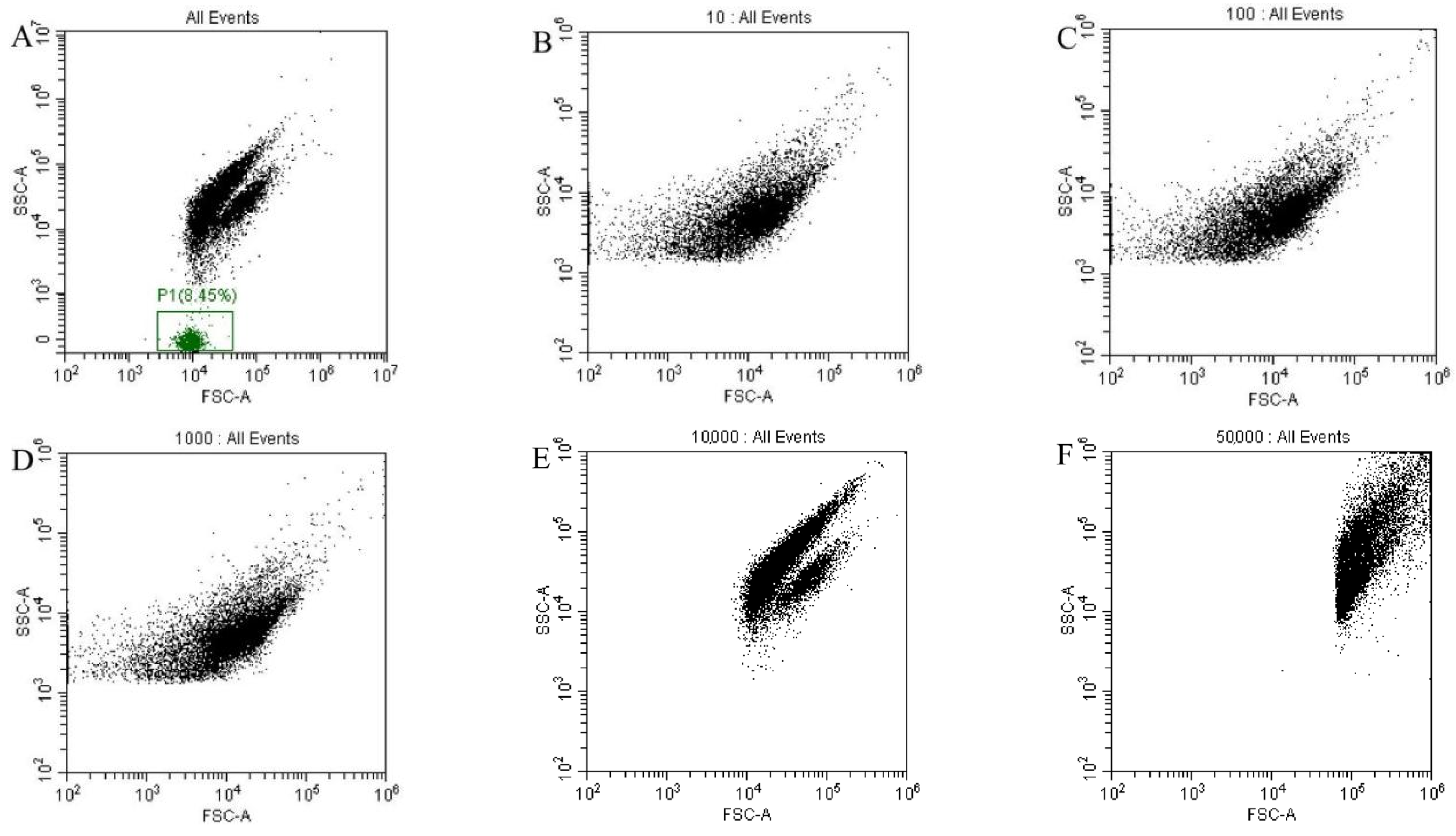
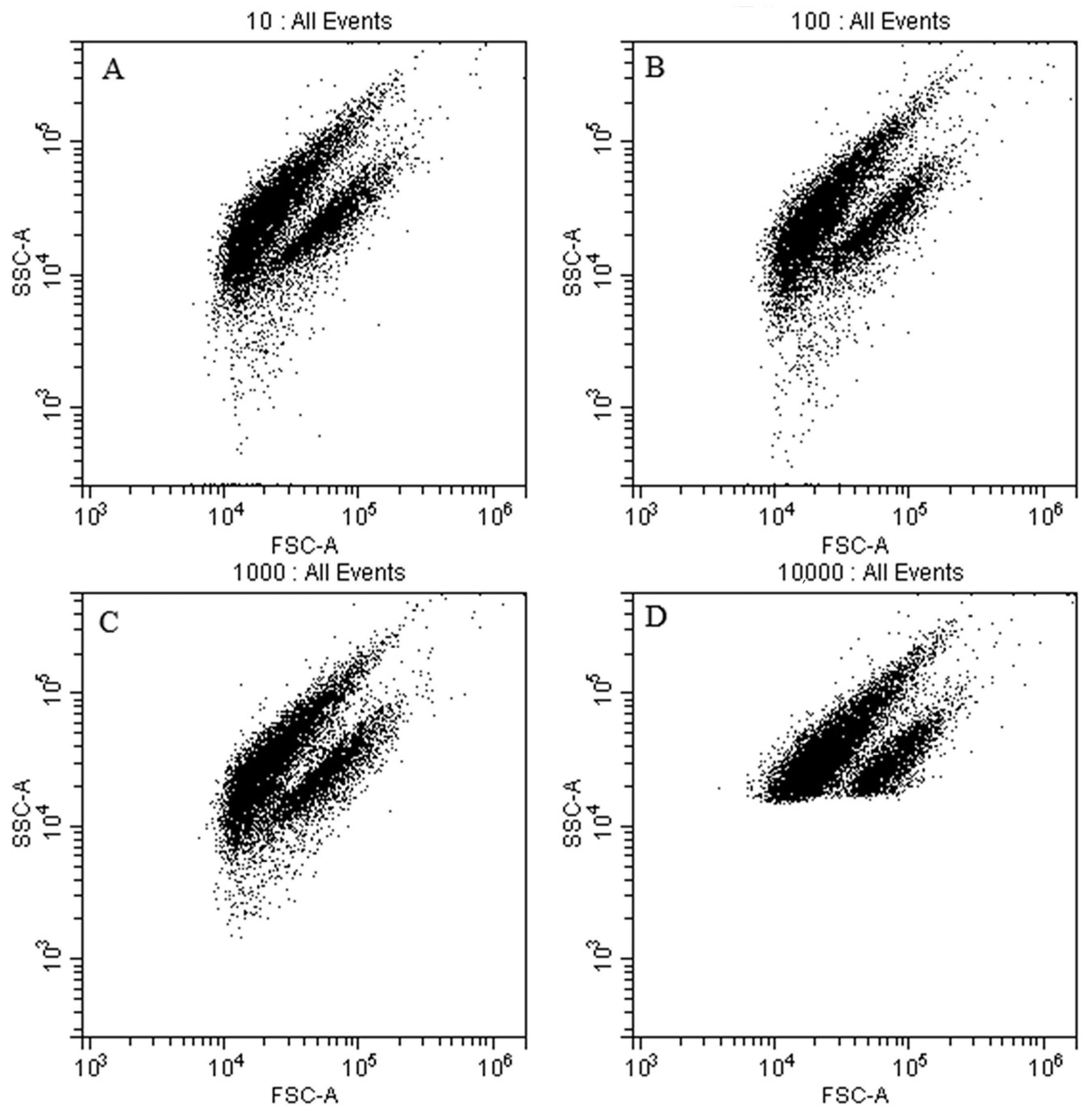
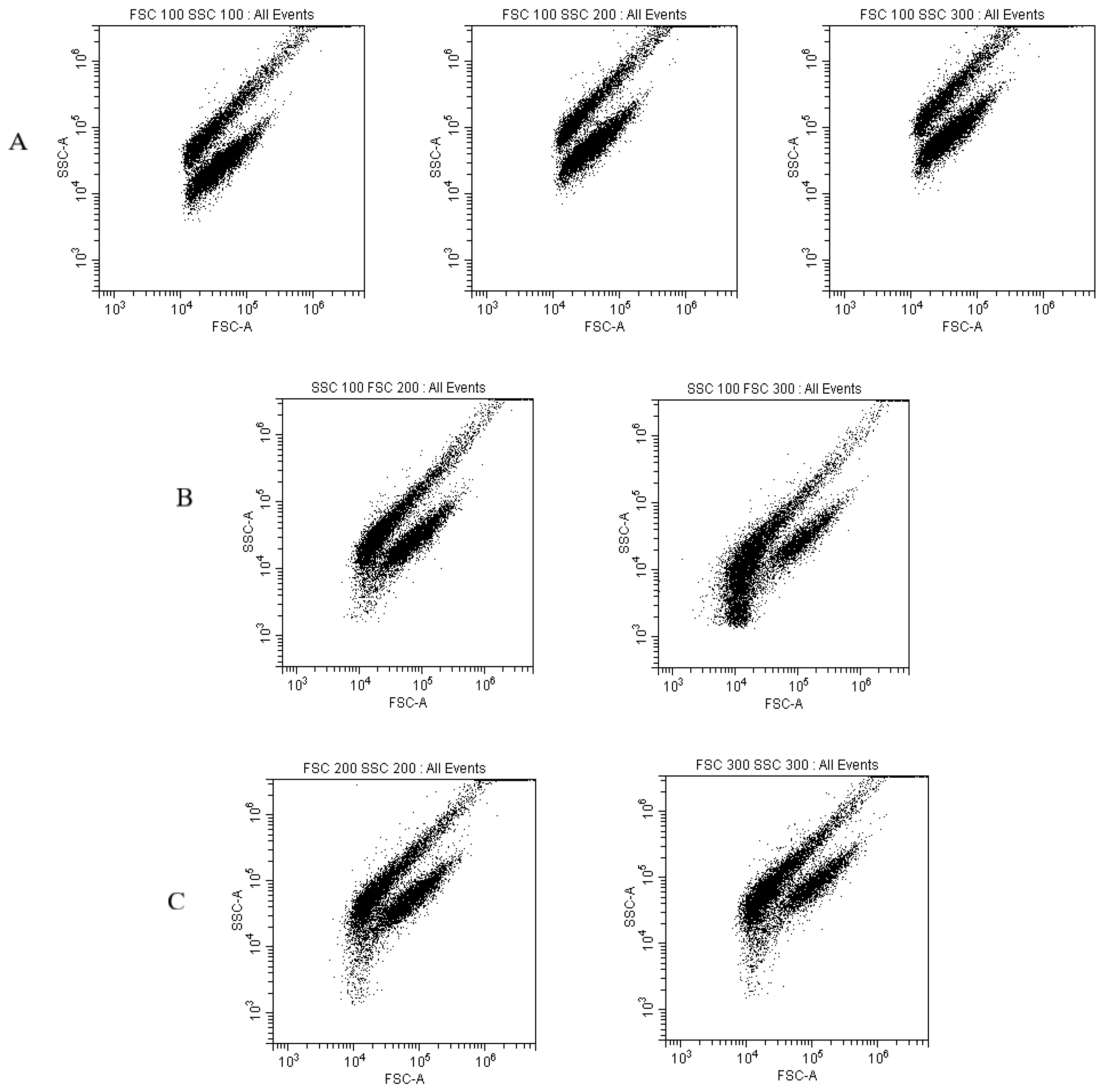
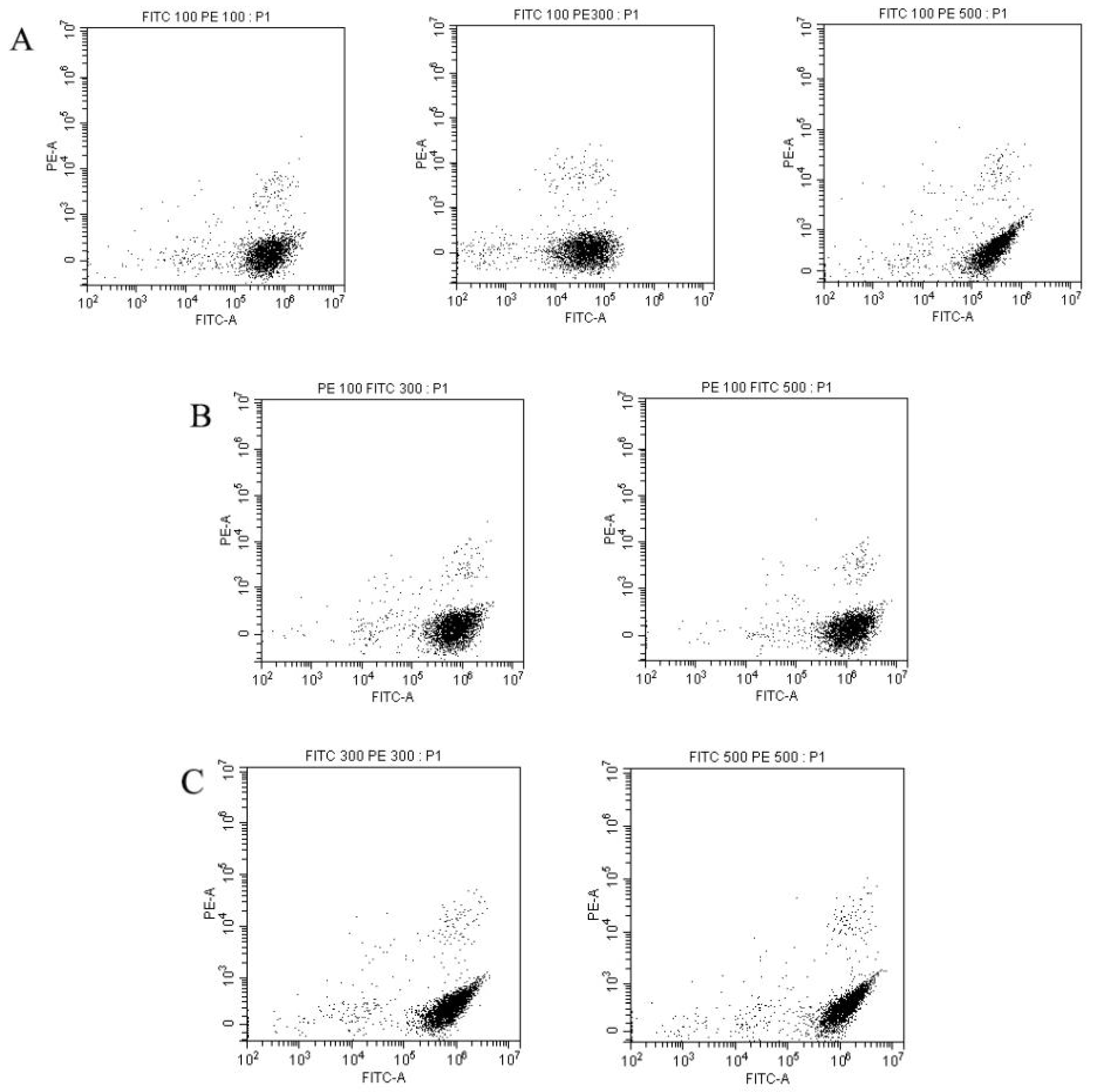

| Level | Amount of CFDA Added (μL) | Dyeing Time t1 (s) | Amount of PI Added (μL) | Dyeing Time t2 (s) |
|---|---|---|---|---|
| 1 | 5 | 5 | 5 | 5 |
| 2 | 10 | 10 | 10 | 10 |
| 3 | 15 | 15 | 15 | 15 |
| Serial Number | Amount of CFDA Added (μL) | Dyeing Time t1 (s) | Amount of PI Added (μL) | Dyeing Time t2 (s) |
|---|---|---|---|---|
| 1 | 15 | 15 | 10 | 5 |
| 2 | 10 | 10 | 15 | 5 |
| 3 | 15 | 5 | 15 | 15 |
| 4 | 10 | 15 | 5 | 15 |
| 5 | 5 | 10 | 10 | 15 |
| 6 | 15 | 10 | 5 | 10 |
| 7 | 10 | 5 | 10 | 10 |
| 8 | 5 | 5 | 5 | 5 |
| 9 | 5 | 15 | 15 | 10 |
| Experiment | Parameters | Viable Count (AFU/μL) | |||
|---|---|---|---|---|---|
| A CFDA Amount (μL) | B Dyeing Time t1 (s) | C PI Amount (μL) | D Dyeing Time t2 (s) | ||
| 1 | 5 | 5 | 5 | 5 | 1661 |
| 2 | 5 | 10 | 10 | 15 | 1762 |
| 3 | 5 | 15 | 15 | 10 | 1802 |
| 4 | 10 | 15 | 5 | 15 | 1897 |
| 5 | 10 | 5 | 10 | 10 | 1782 |
| 6 | 10 | 10 | 15 | 5 | 1739 |
| 7 | 15 | 5 | 15 | 15 | 1628 |
| 8 | 15 | 15 | 10 | 5 | 1786 |
| 9 | 15 | 10 | 5 | 10 | 1824 |
| K1 | 1742 | 1691 | 1794 | 1729 | |
| K2 | 1806 | 1775 | 1777 | 1803 | |
| K3 | 1746 | 1829 | 1723 | 1763 | |
| R | 64 | 138 | 71 | 74 | |
| Factor ranking | B > D > C > A | ||||
| Optimal combination | A2B3C1D2 | ||||
Disclaimer/Publisher’s Note: The statements, opinions and data contained in all publications are solely those of the individual author(s) and contributor(s) and not of MDPI and/or the editor(s). MDPI and/or the editor(s) disclaim responsibility for any injury to people or property resulting from any ideas, methods, instructions or products referred to in the content. |
© 2023 by the authors. Licensee MDPI, Basel, Switzerland. This article is an open access article distributed under the terms and conditions of the Creative Commons Attribution (CC BY) license (https://creativecommons.org/licenses/by/4.0/).
Share and Cite
Ma, X.; Wang, L.; Dai, L.; Kwok, L.-Y.; Bao, Q. Rapid Detection of the Activity of Lacticaseibacillus Casei Zhang by Flow Cytometry. Foods 2023, 12, 1208. https://doi.org/10.3390/foods12061208
Ma X, Wang L, Dai L, Kwok L-Y, Bao Q. Rapid Detection of the Activity of Lacticaseibacillus Casei Zhang by Flow Cytometry. Foods. 2023; 12(6):1208. https://doi.org/10.3390/foods12061208
Chicago/Turabian StyleMa, Xuebo, Lina Wang, Lixia Dai, Lai-Yu Kwok, and Qiuhua Bao. 2023. "Rapid Detection of the Activity of Lacticaseibacillus Casei Zhang by Flow Cytometry" Foods 12, no. 6: 1208. https://doi.org/10.3390/foods12061208






